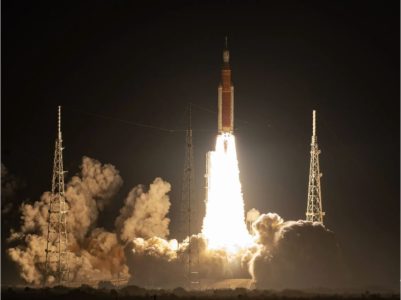More than 30 Metis personnel across three different contracts contributed to today’s historic NASA Artemis I Space Launch System (SLS) launch. Artemis I is the initial uncrewed test flight of NASA’s Artemis program, which in 2025 will land astronauts on the Moon for the first time in nearly 50 years. The launch of the SLS and Orion was a major step in the Artemis program’s history as Orion’s flight to the Moon and back will provide important data for use in preparation of upcoming manned flights.
“I am beyond proud of the exceptional support Metis employees provided to ensure the successful launch of the SLS and transit of the Orion spacecraft,” said Joy Colucci, CEO of Metis. “The Artemis mission and our return to the Moon is a moment in history for all of humanity to share in; for Metis employees to play so many roles in the mission’s success is humbling.”

Image Credit: Bill Ingalls/NASA
Metis employees on the Pad Safety Support Contract (PSSC), NASA Goddard Space Flight Center (GSFC) Space Exploration Network Services and Evolution (SENSE) contract, and at Jet Propulsion Laboratory’s (JPL) Deep Space Network (DSN) made a variety of contributions to the launch and mission. Metis PSSC personnel conducted verification of the SLS rocket’s flight termination system component testing and installation, witnessed battery testing and installation, and caught several potential mission-critical testing faults. Metis staff on SENSE, a Peraton prime contract, are currently monitoring the software used for tracking the Orion spacecraft to provide data on the health of the capsule and are providing status updates to NASA officials. And on DSN, also a Peraton prime contract, Metis Network Operations Analysts (NOAs) are currently supporting Orion communications beyond Near Earth Network (NEN) coverage as the craft travels to and around the Moon.
“Congratulations to NASA, Metis employees, and our Mentor partner Peraton on supporting the launch of SLS and Orion,” said Brian Eslinger, Vice President of Space Programs at Metis. “From SLS pre-launch activities, to the launch itself and Orion’s transit to the Moon, and its eventual return to Earth, Metis personnel are central to many phases of the Artemis I mission. I am proud of how our employees on PSSC, DSN, and SENSE continue to rise to the considerable challenges of Artemis and am excited as we continue to support this important mission into the future.”
The Artemis I mission is scheduled to conclude with Orion’s return to Earth and final splashdown approximately two weeks after its launch. During the duration of Orion’s mission, Metis SENSE and DSN staff will be part of a team providing 24/7 communication support for the spacecraft. Included in the payload of the SLS were eight CubeSats for which Metis DSN staff performed initial communication acquisition following deployment. During the development of the BioSentinel CubeSat that is onboard the second stage of the SLS, Metis performed considerable engineering to the navigation and orbital design in support of the mission objective to study the impact of space radiation on living organisms beyond low-Earth orbit.
Metis personnel are set to continue playing an integral role in future Artemis missions. Metis employees working on the Simulation and Aircraft Services (SAS) contract at NASA Langley Research Center (LaRC) provide software and hardware support for the Artemis Human Landing System Handling Qualities project (aSHaQ). The aSHaQ team is designing and developing the simulation facility supporting training for the landing of the Artemis Human Landing System on the Lunar south pole. SAS team has worked with Dynetics in further enhancing the Test and Evaluation Simulator (TED) Lunar Flight Deck (LFD) simulator capabilities to meet the requirements of the project.
